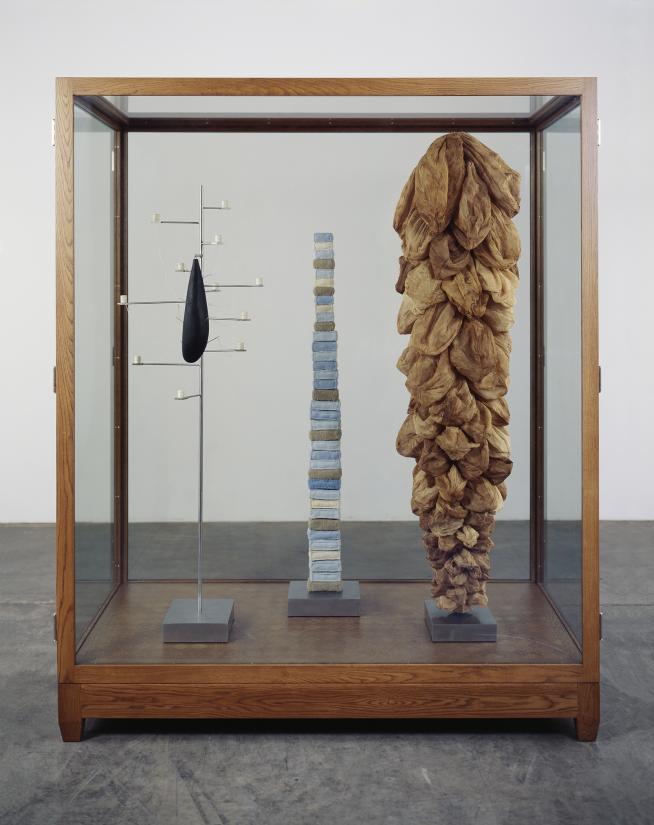Bourgeois’s sculptures are raw and striking. She probes the areas of greatest pain, relentlessly portraying the truth she finds there. With surgical precision she is able to capture her most intense feelings and transform them into artistic statements. In Untitled from 2005 she positions three different figures in a glass showcase as a sort of self-portrait.
Delimited space
The glass showcase sparks associations to Bourgeois’s early presentations of women trapped inside houses and bell jars. We are familiar with the showcase from museum collections as a way of storing or displaying objects – and as a way of directing our gaze. In this piece, she invites us to direct our attention at the three figures. She seems at once to use the showcase to protect and expose them. Three figures in different materials and volumes stand side by side behind the glass. All unique, yet also defined by their mutual relationship.
Textile, rubber and thread
The figure on the left is based on a simple iron structure. The skeleton-like figure stands straight-backed, the its many arms pointing in different directions. A large drop in black rubber hangs from one of the arms, punctured by threaded needles. In Bourgeois’s art, threads almost always represent links to her family history and her parents’ tapestry workshop. They are also a reference to her fascination with spiders and their webs, which act both as lifelines and nerve paths. The middle figure consists of stacked pale blue cushions, probably sewn from the artist’s own discarded clothes. Despite the seemingly stable character of this construction, the materials also convey a quality of vulnerability that makes us wonder how long the tower night remain standing. The third and last figure has a strikingly voluminous body. Old brown fabric bags are draped and layered heavily on top of each other. Shrivelled and wrinkly, they resemble and aging female body, a mother figure that has lost its power. Are the three sculptural forms in fact different aspects of the same figure?
About Louise Bourgeois
The French-American visual artist Louise Bourgeois (1911–2010) was born and raised in Paris; her parents had a workshop where they restored tapestries. After initially studying mathematics and geometry at the Sorbonne, Bourgeois chose art as her path and was accepted into École des Beaux Arts and École du Louvre. In 1938 she married the American art historian Robert Goldwater. Shortly before the break-out of the Second World War they left France for New York.
When her father died in 1951, she embarked on a lengthy course of psychoanalysis that lasted until 1985. Her art is often read from a biographical perspective but reaches far beyond the personal realm. in her early career, she focused mainly on printing and painting and did not begin to pursue a more sculptural expression until the late 1940s. Bourgeois had her main breakthrough in the international art scene when MoMA in New York showed a large retrospective exhibition of her work.



